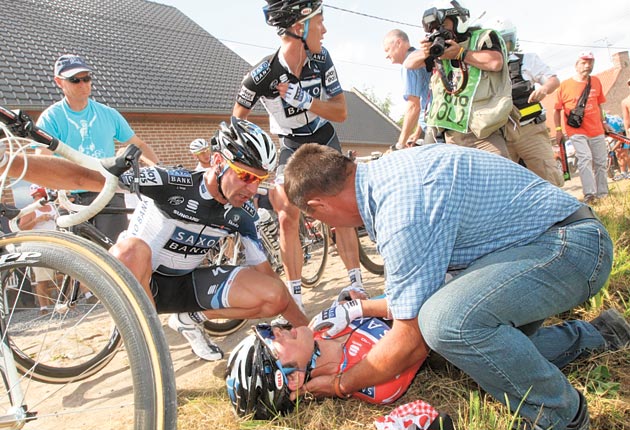Cycling: How to survive the Tour: avoid cobbles, coppers, dogs and bags
This year's race has been full of falls, but that's nothing new as this crash course to hitting the dirt reveals

Cuts, grazes, blood and bruises have been the feature of this year's Tour and there is a good chance there will be more on the way today as the stage is set to finish with a typically manic sprint for the line.
This Tour has seen more than its fair share of falls and, although it was ever thus in the heat of professional cycling, accidents are so common that the sport has developed its own written and unwritten rules about them.
Back in 1904, the Tour's second year, riders who abandoned one stage after falling were permitted to start the next along with everyone else – a rule that was quietly dropped after riders soon cottoned on that they could "crash out" and rejoin the next day without penalty. Although that was changed, it is still the case that time lost from crashes at certain points does not count – such as within the last three kilometres of a stage expected to end in a bunch sprint.
Even if a rider falls earlier in a stage, though, he will quite often escape penalty because, with the frequency of crashes, if one rider goes down the rest will wait for him to catch up. That was the case in 2004 when Germany's Jan Ullrich span off into a hayfield at 80kmph on a descent of the Pyrenees. Despite having a chance to take a definitive step towards winning the race outright, Lance Armstrong chose to wait.
But differences in how the bunch and riders will react to a crash can be subtle. If the pile-up happens in the final kilometres of a stage, say, no one is expected to wait. If, however, it is so serious that a rider in the peloton dies – as happened when Armstrong's team-mate Fabio Casartelli span off in 1995, striking his head – the next stage will become a two-wheeled funeral procession, with riders slow-pacing the entire day.
If crashes are inevitable when you have a 200-strong peloton speeding along city centre roads, or when riders are bumping along the cobbles, some other instances down the years have been bizarre beyond belief. Armstrong's 2003 Tour bid almost collapsed when he tangled with a spectator's plastic bag. In the early stages of this tour Britain's David Millar came a cropper after a hitting a dog. The French rider Laurent Jalabert crashed into a photograph-taking policeman in 1994, while the Norwegian Thor Hushovd collided with a giant publicity hand in 2006 and, with blood spattering over other riders from an artery in his arm, he crossed the line, looked down – and fainted.
Most riders jump back in the saddle after hitting the dirt but others never fully recover. The three-times Tour podium finisher Joseba Beloki was a shadow of his former self after he broke his hip, right elbow and right wrist *2003. His problems were physical but, even if fitness is fully regained, the psychological scars may not heal, particularly for the sprinters. Jalabert had a terrible fall in Valenciennes, smashing his teeth and his face in a bunch sprint in 1994. Although he won numerous races afterwards, he was never as successful again in bunch sprints.
Considering that Mark Cavendish lost 10 per cent of his body skin in a crash in the Tour of Switzerland recently, he has done well to win three Tour sprints. "You can't underestimate the effect in your head," Britain's top sprinter of the 1980s, Malcolm Elliot, says. "Gaps you might have gone for, leaning a little bit on somebody, you hesitate a little bit more – and in sprinting, which is about positioning, it makes all the difference. If you've got two or three weeping wounds, the thought of going down on them in a bunch sprint has to make you think twice about getting involved."
In a sport that is no stranger to cheats, not all crashes are accidental. The late José Manuel Fuente, third in the 1973 Tour, once explained how he discovered during a stage he would be tested for doping afterwards – and he knew the result would be positive. Fuente's solution: "I thought of throwing myself down a ravine, but there was too much mist and I didn't want to break my neck," he said.
"So in the final sprint, I loosened my front wheel and rode towards the barriers. I crashed, ended up feigning unconsciousness and got taken away in an ambulance. It wasn't pretty, but at least my career wasn't over."
Subscribe to Independent Premium to bookmark this article
Want to bookmark your favourite articles and stories to read or reference later? Start your Independent Premium subscription today.

Join our commenting forum
Join thought-provoking conversations, follow other Independent readers and see their replies